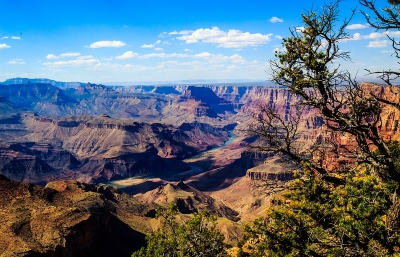
Grand Canyon, immense canyon cut by the Colorado River in the high plateau region of northwestern Arizona, U.S., noted for its fantastic shapes and coloration.
The Grand Canyon lies in the southwestern portion of the Colorado Plateau, which occupies a large area of the southwestern United States and consists essentially of horizontal layered rocks and lava flows. The broad, intricately sculptured chasm of the canyon contains between its outer walls a multitude of imposing peaks, buttes, gorges, and ravines. It ranges in width from about 175 yards (160 metres) to 18 miles (29 km) and extends in a winding course from the mouth of the Paria River, near Lees Ferry and the northern boundary of Arizona with Utah, to Grand Wash Cliffs, near the Nevada state line, a distance of about 277 miles (446 km); the first portion of the canyon—from Lees Ferry to the confluence with the Little Colorado River—is called Marble Canyon. The Grand Canyon also includes many tributary side canyons and surrounding plateaus.
Terrestrial plant and animal fossils are not abundant in the Grand Canyon’s sedimentary rocks because of the age of the rocks. Fossils are mostly of primitive algae and such marine species as mollusks, corals, trilobites, and other invertebrates.
Animal life in the Grand Canyon area today, however, is varied and abundant. Common mammals are the many varieties of squirrels, coyotes, foxes, deer, badgers, bobcats, rabbits, chipmunks, and kangaroo rats. In addition, the canyon region is home to a great many bird species, including raptors such as bald eagles and peregrine falcons and the rare California condor. Fish species include trout and (in the Little Colorado River) the rare humpback chub (Gila cypha).
Plant life is also varied. In the bottom of the canyon, where temperatures in the summer can reach a high of 120 °F (49 °C), are willows and cottonwoods, which require abundant water during the growing season. Drought-resistant plants include tamarisks, yuccas, agaves, and numerous species of cactus. Efforts have been made to eradicate stands of the invasive tamarisk. On the canyon rims, north and south, there is a wide assortment of plant life. Typical of the South Rim, which receives about 15 inches (380 mm) of precipitation annually, is a well-developed ponderosa pine forest, with scattered stands of piñon pine and juniper. Bush vegetation consists mainly of scrub oak, mountain mahogany, and large sagebrush. On the North Rim, which receives 26 inches (660 mm) of precipitation annually, are magnificent forest communities of ponderosa pine, white and Douglas fir, blue spruce, and aspen. Under less optimum conditions the plant life reverts to the desert varieties.
Credit : Britannica
Picture Credit : Google




